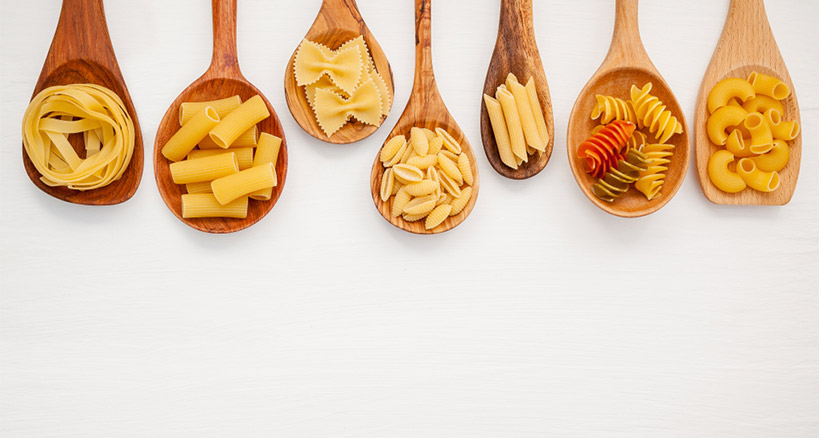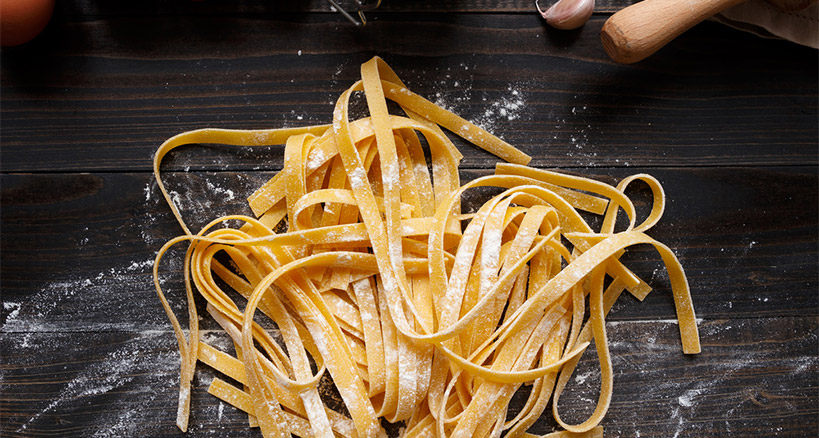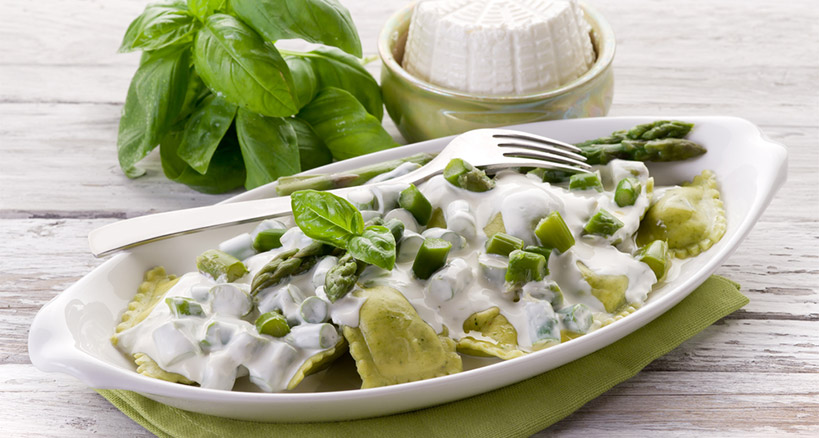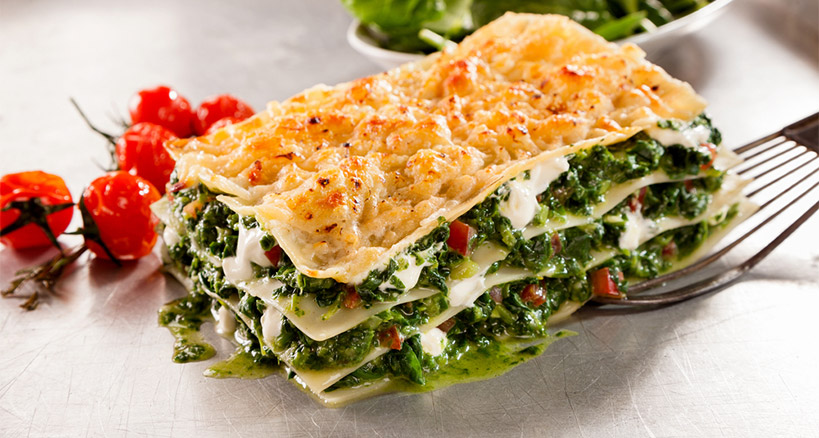
New Ways to Serve Good, Old Pasta
When it comes to casual catered buffets, there is probably nothing as versatile and, therefore, as ubiquitous, as pasta. In so many shapes and forms, pasta is the chameleon of dishes, changing its shape and size to fit any occasion. Now, pasta is getting a long-needed facelift, thanks to restaurants and chefs who are raising the bar for pasta around the world. With a nip here and a tuck there, you can hone the classics and invent new pasta dishes that will impress and satisfy even the most discerning client.
Who Doesn’t Love Pasta?
Everyone loves pasta. According to the International Pasta Organization, dried pasta is the most prominent pasta variety sold in the United States and sales reach about $3.3 billion annually. The chilled and fresh pasta retail value is projected to reach $340 million this year, while in 2016 there were 1.16 billion units of pasta sold in U.S. supermarkets. That’s a lot of pasta!
There are many reasons why pasta is so popular. First reason is that it is simply so good, taste-wise and even health-wise. Although carbohydrates in general, and pasta in particular, have gotten a bad rap lately, nutritionists agree that pasta is a healthy food and that complex carbohydrates are essential for any diet, especially when paired with other healthy foods, such as greens, vegetables, olive oil, etc. As the Pasta Fits website says, pasta is a “perfect foundation for healthy, nutritious, and satisfying meals. It is generally eaten with nutrient-dense food partners, such as fiber-filled vegetables and beans, heart healthy fish and monounsaturated oils, antioxidant-rich tomato sauce, and protein-packed cheeses, poultry, and lean meats.”
There’s Simply Nothing Like Pasta
Pasta is unique because it can be humble in taste, and yet, even prepared in the simplest ways, it can be extraordinary. It is also highly affordable, making it a practical solution for caterers. And, because of its versatility, you can prepare a dish with a simple and healthy sauce or dressing, in mere minutes. Today, with the advent of fast cooking pasta, which has a higher water content compared to normal pasta, your cooked pasta can be ready in four minutes. Furthermore, pasta is easy to transport and store, as it does not need a refrigerator; it takes up little room; it does not weigh much; and, it does not go bad in hot or cold temperatures. Pasta is also adaptable to various styles of food and types of culture, taking on the flavors of nations around the world.
Guide to Different Types of Pasta
In the words of food author Peter Begg, pasta is “up there with pizza, gelato, and tiramisu as one of the great culinary inventions to come out of Italy.” Bon Appetit’s pasta guide will help you figure out the different types of pastas and their uses. Here is an abbreviated version:

Spaghetti: “The satisfaction of chewing on a beautiful bundle of noodles, twirled carefully around your fork, is a thing of beauty,” says Begg. Spaghetti is usually served with loose, sweet tomato sauces; no sauce at all; or with a light flavored broth.
Penne: Penne are tubular, and cut on an angle. Ridges help thicker sauces cling to the pasta, ensuring the right ratio with every piece. Penne is often the star of baked ziti.
Conchiglie and orecchiette: Shaped like small shells and ears, respectively, their cup-like form helps to hold heavier, vegetable-based sauces.
Linguine: Similar to spaghetti, linguini’s flatter shape makes it hang onto light, creamy sauces.
Bucatini: This fatter, hollow spaghetti is great with thick ragù-style sauces. The hole helps the sauce make its way into the noodles.
Spirali and fusilli: These curly pastas are basically the same, and they’re perfect for thick meaty sauces because the chunks get caught in the screw threads.
Farfalle: Sometimes called bowties, these butterfly-shaped pieces of pasta have crinkly edges. Kids love this shape and this pasta is great for cold pasta salads.
Macaroni: Everyone is familiar with macaroni, from both mac and cheese and minestrone soup, both of which you can update and jazz up to add to your new and improved pasta menu.
Lasagne: Lasagne, traditional or meat-free, is one of the world’s favorite dishes. Fresh egg pasta, readily available, will upgrade your usual recipe.
Cannelloni: Cannelloni is usually paired with the same ingredients as lasagna, except that with cannelloni, the pasta is stuffed with the filling, rather than layered.
Ravioli: Ravioli is a small piece of pasta, folded over a dollop of stuffing and pinched together to form a delicate parcel. The stuffing could be meat, vegetables, fish, or cheese. Fillings and sauces should complement each other. (More on ravioli, below.)
Pappardelle, fettucine, and tagliatelle: these three flat, ribbon-like pastas are similar; pappardelle is a bit wider (though narrower than lasagna noodles).
Pasta is Beautiful
In this age of Instagrammable food, pasta can be among the most photogenic dishes you serve. In a New York restaurant called Raviolo, ravioli is served undressed, with a side of red sauce or melted cheese for dipping. Each beautiful piece of ravioli is shaped like a little round hat or a wrapped candy with twisted ends, and made with dough ranging in color from light green (spinach or parsley) to muted mauve (tomato). A neon sign on the wall of the restaurant’s dining room sums it up: “Life is a combination of magic and pasta.”
Ravioli is a great way to expand your pasta repertoire, with fillings that can be bold and satisfying, or subtle and heavenly. Consider making ravioli filled with comfort foods like eggplant Parmesan or ground meat and bread crumbs. Think of ravioli as a pasta pocket for just about anything from meat to fish to veggies and more.
A New Level of Ravioli
The Oh My Vegies website has a wonderful recipe for asparagus ravioli with pan-seared cremini mushrooms that will knock the socks off all your guests, particularly vegetarians who will love the hardy, yet no-meat filling of this rich dish.

Asparagus Ravioli with Pan-Seared Mushrooms Recipe
Asparagus Ravioli
Ingredients
- 1 lb. asparagus, trimmed and cut into small piece
- 1 Tbsp. olive oil
- salt and pepper to taste
- 3/4 c. ricotta cheese
- 1/4 c. grated Parmesan cheese
- 1 1/4 lbs. fresh pasta dough, rolled into 6 equal-sized sheets
Instructions
-
- Preheat oven to 400 degrees.
- Toss asparagus with olive oil, salt, and pepper on a rimmed baking sheet. Roast for about 10 minutes, or until softened and just beginning to brown, stirring halfway through cooking time. Remove from oven and cool slightly.
- Transfer asparagus to large bowl. Add ricotta, parmesan, and salt; stir until well-combined.
- Place one sheet of pasta onto a well-floured surface; brush with water. Drop filling onto the pasta by the teaspoonful, about 1 inch apart. Take a second sheet of pasta and place it on top of the first, carefully pressing to seal around filling.
- Use pasta cutter, knife, or pizza cutter to cut individual ravioli. Press along edges to make sure they are sealed.
- Bring a large pot of salted water to a boil. Drop in ravioli, about 6 at a time, and cook for 3-4 minutes, or until they float to the top of the pot. Drain in a colander.
Mushroom Sauce for Asparagus Ravioli
Ingredients
-
-
- 12-16 asparagus ravioli, cooked (see recipe above)
- 1 Tbsp. olive oil
- 8 oz. cremini mushrooms, trimmed and halved
- 2 Tbsp. red wine
- 1 Tbsp. butter
- Salt and pepper to taste
- Parmesan cheese and chopped parsley for serving
-
Instructions
-
-
- Heat oil in a medium skillet over high heat. Add mushrooms; cook 6-7 minutes, stirring often, until mushrooms are deep brown in color.
- Carefully pour in wine and cook until completely evaporated, about 2-3 minutes. Add butter and cook until melted. Remove from heat and season with salt and pepper.
- Pour mushrooms and butter over ravioli. Sprinkle with parmesan cheese and parsley before serving.
-
Let Loose with Pasta
Ingrid Beer, of the Cozy Apron website maintains that it is high time pasta got the upgrade it needs. Beer, a Los Angeles-based recipe developer and writer, insists that sometimes life – and food – needs an infusion of something different now and then. Even the most tried-and true dish can be changed to make it fresh and interesting, and to turn it into a new classic. She suggests that taking “the essence” of a dish you are familiar with to create something new and original, can “keep things fun and interesting.”
In the same vein, the Kitchen website presents Roasted Vegetable Lasagna, a fabulous take on classic lasagna with veggies galore to make it special.

Ina Garten’s Roasted Vegetable Lasagna
Ingredients
-
-
-
- 1 1/2 pounds eggplant, unpeeled, sliced lengthwise 1/4-inch thick
- 3/4 pound zucchini, unpeeled, sliced lengthwise 1/4-inch thick
- 2/3 cup olive oil
- 1 tablespoon dried oregano
- Kosher salt and freshly ground black pepper
- 1 tablespoon minced garlic (3 cloves)
- 10 ounces lasagna noodles, cooked
- 16 ounces whole-milk ricotta
- 8 ounces creamy garlic-and-herb goat cheese, at room temperature
- 2 extra-large eggs, lightly beaten
- 1/2 cup chopped fresh basil leaves, lightly packed
- 1 cup freshly grated Parmesan cheese, divided
- 4 1/2 cups bottled or homemade tomato sauce
- 1 pound lightly salted fresh mozzarella, very thinly sliced
-
-
Instructions
-
-
-
- Preheat the oven to 375°F. Arrange the eggplant and zucchini in single layers on 3 sheet pans lined with parchment paper. Brush them with the olive oil on both sides. Sprinkle with the oregano, 1 tablespoon salt, and 1 1/2 teaspoons pepper. Roast for 25 minutes; sprinkle the garlic evenly on the vegetables, and roast for another 5 minutes, until the vegetables are cooked through. Remove from the oven and lower the temperature to 350°F.
- Combine the ricotta, goat cheese, eggs, basil, 1/2 cup of the Parmesan, 1 1/2 teaspoons salt, and 3/4 teaspoon pepper in the bowl of an electric mixer fitted with the paddle attachment and mix on low speed.
- Spread 1 cup of the tomato sauce in a 9 × 13 inch baking dish. Arrange a third of the vegetables on top, then a layer of the noodles (cut to fit), a third of the mozzarella, and a third of the ricotta mixture in large dollops between the mozzarella. Repeat twice, starting with the marinara. Spread the last 1 1/2 cups of sauce on top and sprinkle with the remaining 1/2 cup of Parmesan.
- Place the dish on a sheet pan lined with parchment paper and bake for 60 to 70 minutes, until the lasagna is browned and bubbly. Allow to rest for 10 minutes and serve hot.
-
-
Your Clients Will Be Thrilled with Your New Versions of Old Favorites
Pasta is a great food with which to step out of your comfort zone, allowing you to shake up your menu, which may be getting a little tired. With a little effort and ingenuity, and a pot full of different shape pastas, you can bring pasta to an unrecognizable new level while retaining its integrity and basic wholesomeness. Upgraded pasta – modern, current, and trendy – will cement your reputation as the caterer of the moment.